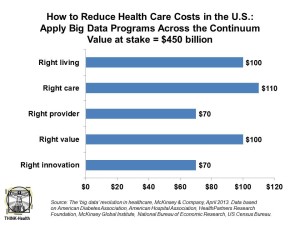 Exploiting Big Data in industry is Big News these days, and nowhere is the potential for leveraging the concept greater than in health care. McKinsey & Company estimates that harnessing big data across five dimensions of health care could yield nearly one-half trillion dollars’ worth of value in The ‘big data’ revolution in healthcare. The chart summarizes McKinsey’s calculations on the value of Big Data in health care at its maximum.
Exploiting Big Data in industry is Big News these days, and nowhere is the potential for leveraging the concept greater than in health care. McKinsey & Company estimates that harnessing big data across five dimensions of health care could yield nearly one-half trillion dollars’ worth of value in The ‘big data’ revolution in healthcare. The chart summarizes McKinsey’s calculations on the value of Big Data in health care at its maximum.
Before digging into the value potential, just what is Big Data in health care? Statistics and information are generated in the health care system about patients: say, during visits with physicians, in lab tests, via digital imaging procedures, when filling prescriptions, and during inpatient hospital stays. All of these data points “live” in various data systems: in physician office records systems (in paper files and, increasingly, in electronic health records, or EHRs), pharmacy claims systems (housed in systems managed by pharmacy benefits management companies and health plans), hospitals’ information systems, and — for people who self-track data at home and on-the-go but don’t communicate it to health providers, in consumers personal health records in the internet cloud (say, via the Withings Wi-Fi weight scale or Fitbit online portals).
By analyzing the data about patients, prescriptions
What’s driving Big Data in health care is first and foremost cost: the economics of health care especially in the U.S. are unsustainable, driving the long-term budget deficit for the nation and producing sub-optimal outcomes like relatively high infant mortality, morbidity, consistent application of standard treatments for heart disease for women and people of color. A second factor motivating Big Data adoption is data liquidity, thanks to the adoption of EHRs and health data standards that can move data from one system (“here”) to another (“there”). Third, technology is developing that enable researchers to combine and analyze data while protecting patient privacy. And finally, the U.S. government is promoting the use of data in the private sector for improving public health through hackathons, demonstration projects and evangelizing open data standards., procedures and outcomes, health care managers, researchers, and other stakeholders can predict potential adverse health events in patients, identify optimal medications and therapies for an individual patient, and channel patients to the most appropriate treatments at the right time and place (for example, an outpatient minimally invasive less expensive procedure versus a more invasive, more expensive and risky inpatient surgery).
Now that the stage is set for Big Data to benefit the health system, McKinsey identifies five areas where harnessing big data generated by the health system could create greater efficiencies and scale economies for the system, termed new value pathways:
- Right living, which supports patients taking active roles in their health care and preventing the onset of disease. This pathway supports ongoing “nudges” to help people make good health decisions every day, bolstering nutrition and physical activity, and seeking health care when needed early, not postponed.
- Right care, to ensure that people get the right treatment at the right time. This involves health care coordination across providers and settings to avoid the duplication of care (e.g., multiple tests and imaging).
- Right provider, which matches patients with the best provider for their individual clinical situation. This can mean channeling a patient to a lower-cost provider, such as a diabetes educator or nurse practitioner when the physician is not needed.
- Right value, which focuses on rewarding health providers who product best outcomes, and ridding the system of fraud, abuse and waste.
- Right innovation. which promotes continuous improvement and productivity in health care processes and research and development.
Getting to Big Data Nirvana requires re-alignment of several key barriers in the health system, specifically:
- Privacy and data security
- Payment incentives that reward value, not volume (that is, moving from a fee-for-service payment system toward more bundled, value-based payment)
- Partnerships across industry segment silos, such as payors and providers working together, biopharma industry and payors, and employees and their companies coming together to drive value
- Data analysis capabilities, which currently are stymied by a lack of data scientists and health informaticists (health IT experts).
Health Populi’s Hot Points: An enabling strategy mentioned in the report’s conclusion is to promote transparency as a cultural norm. “Many executives believe data transparency is just as likely to product damaging consequences as new opportunities,” the report observes. “But if leaders don’t pursue transparency efforts, regulators or other external bodies may do so on their behalf — and not gently.”
As with all new technological developments in health care, successful adoption and proliferation has little to do with the technology itself: success is built on changing the culture, workflow, business processes, and relationships within organizations and, as McKinsey rightly points out, in industry stakeholders crossing corporate chasms between payors and pharma, providers and consumers, employers and employees. Harnessing and analyzing the data will be the easier part of the Big Data Opportunity: the Big Data Revolution will come when these stakeholders can get to “kumbayah” and partner for the benefit of patient outcomes and the larger health economy.




 Thanks to Feedspot for naming this blog, Health Populi, as a
Thanks to Feedspot for naming this blog, Health Populi, as a